Lifecycle Assessment and Techno-Economic Analysis of Biochar Pellet Production from Forest Residues and Field Application
Abstract
:1. Introduction
2. Materials and Methods
2.1. System Description
2.1.1. Harvest and Post-Harvest Logistics Operations
2.1.2. Biochar Production Systems
2.1.3. Biochar Packaging, Transport, and Field Application
2.2. Modeling Framework
2.2.1. Lifecycle Assessment
Goal and Scope Definition
Lifecycle Inventory (LCI) Analysis
Lifecycle Impact Assessment
2.2.2. Techno-Economic Analysis (TEA)
Capital Cost
Operating Cost
Cost of Logistics Operations (Inbound and Outbound)
Financial Analysis
2.3. Scenario Description
3. Results and Discussion
3.1. Global Warming Impact of Biochar Pellet Production through Portable Systems
3.2. Techno-Economic Analysis of Biochar Pellet Production through Portable Systems
3.3. Sensitivity Analysis Results
4. Conclusions
Author Contributions
Funding
Institutional Review Board Statement
Informed Consent Statement
Data Availability Statement
Acknowledgments
Conflicts of Interest
References
- Scotti, R.; Bonanomi, G.; Scelza, R.; Zoina, A.; Rao, M.A. Organic Amendments as Sustainable Tool to Recovery Fertility in Intensive Agricultural Systems. J. Soil Sci. Plant Nutr. 2015, 15, 333–352. [Google Scholar] [CrossRef] [Green Version]
- Agegnehu, G.; Srivastava, A.K.; Bird, M.I. The Role of Biochar and Biochar-Compost in Improving Soil Quality and Crop Performance: A Review. Appl. Soil Ecol. 2017, 119, 156–170. [Google Scholar] [CrossRef]
- Aller, D.M.; Archontoulis, S.V.; Zhang, W.; Sawadgo, W.; Laird, D.A.; Moore, K. Long Term Biochar Effects on Corn Yield, Soil Quality and Profitability in the Us Midwest. Field Crops Res. 2018, 227, 30–40. [Google Scholar] [CrossRef] [Green Version]
- Sahoo, K.; Bilek, E.; Bergman, R.; Mani, S. Techno-Economic Analysis of Producing Solid Biofuels and Biochar from Forest Residues Using Portable Systems. Appl. Energy 2019, 235, 578–590. [Google Scholar] [CrossRef]
- Tilman, D.; Socolow, R.; Foley, J.A.; Hill, J.; Larson, E.; Lynd, L.; Pacala, S.; Reilly, J.; Searchinger, T.; Somerville, C.; et al. Beneficial Biofuels—The Food, Energy, and Environment Trilemma. Science 2009, 325, 270–271. [Google Scholar] [CrossRef] [PubMed] [Green Version]
- Bergman, R.; Berry, M.; Bilek, E.T.; Bowers, T.; Eastin, I.; Ganguly, I.; Han, H.-S.; Hirth, K.; Jacobson, A.; Karp, S. Waste to Wisdom: Utilizing Forest Residues for the Production of Bioenergy and Biobased Products; 78: Biomass Research and Development Initiative Program Award Number DE-EE0006297; US Department of Energy: Washington, DC, USA, 2018.
- USDOE. 2016 Billion-Ton Report: Advancing Domestic Resources for a Thriving Bioeconomy, Volume 1: Economic Availability of Feedstocks; Stokes, B.J., Langholtz, M.H., Eaton, L.M., Eds.; ORNL/TM-2016/160; Oak Ridge National Laboratory, U.S. Department of Energy: Oak Ridge, TN, USA, 2016.
- Cook, P.S.; Becker, D.R. State Funding for Wildfire Suppression in the Western Us; University of Idaho: Moscow, ID, USA, 2017; 70p. [Google Scholar]
- Berrill, J.P.; Han, H.S. Carbon, Harvest Yields, and Residues from Restoration in a Mixed Forest on California’s Coast Range. For. Sci. 2017, 63, 128–135. [Google Scholar] [CrossRef]
- Jeffery, S.; Bezemer, T.M.; Cornelissen, G.; Kuyper, T.W.; Lehmann, J.; Mommer, L.; Sohi, S.P.; van de Voorde, T.F.; Wardle, D.A.; van Groenigen, J.W. The Way Forward in Biochar Research: Targeting Trade-Offs between the Potential Wins. GCB Bioenergy 2015, 7, 1–13. [Google Scholar] [CrossRef] [Green Version]
- Wright, M.M.; Daugaard, D.E.; Satrio, J.A.; Brown, R.C. Techno-Economic Analysis of Biomass Fast Pyrolysis to Transportation Fuels. Fuel 2010, 89, S2–S10. [Google Scholar] [CrossRef] [Green Version]
- Yazan, D.M.; van Duren, I.; Mes, M.; Kersten, S.; Clancy, J.; Zijm, H. Design of Sustainable Second-Generation Biomass Supply Chains. Biomass Bioenergy 2016, 94, 173–186. [Google Scholar] [CrossRef] [Green Version]
- Parkhurst, K.M.; Saffron, C.M.; Miller, R.O. An Energy Analysis Comparing Biomass Torrefaction in Depots to Wind with Natural Gas Combustion for Electricity Generation. Appl. Energy 2016, 179, 171–181. [Google Scholar] [CrossRef] [Green Version]
- Sahoo, K.; Bilek, E.; Bergman, R.; Kizha, A.R.; Mani, S. Economic Analysis of Forest Residues Supply Chain Options to Produce Enhanced-Quality Feedstocks. Biofuels Bioprod. Biorefining 2018, 13, 514–534. [Google Scholar] [CrossRef]
- Berry, M.; Sessions, J. The Economics of Biomass Logistics and Conversion Facility Mobility: An Oregon Case Study. Appl. Eng. Agric. 2018, 34, 57–72. [Google Scholar] [CrossRef] [Green Version]
- Bergman, R.D.; Zhang, H.; Englund, K.; Windell, K.; Gu, H. Estimating Ghg Emissions from the Manufacturing of Field-Applied Biochar Pellets. In Proceedings of the 59th International Convention of Society of Wood Science and Technology, Curitiba, Brazil, 6–10 March 2016. [Google Scholar]
- Riva, L.; Surup, G.R.; Buø, T.V.; Nielsen, H.K. A Study of Densified Biochar as Carbon Source in the Silicon and Ferrosilicon Production. Energy 2019, 181, 985–996. [Google Scholar] [CrossRef]
- Dumroese, R.K.; Heiskanen, J.; Englund, K.; Tervahauta, A. Pelleted Biochar: Chemical and Physical Properties Show Potential Use as a Substrate in Container Nurseries. Biomass Bioenergy 2011, 35, 2018–2027. [Google Scholar] [CrossRef]
- Bartocci, P.; Barbanera, M.; Skreiberg, O.; Wang, L.; Bidini, G.; Fantozzi, F. Biocarbon pellet production: Optimization of pelletizing process. Chem. Eng. Trans 2018, 65, 355–360. [Google Scholar]
- Badger, P.; Badger, S.; Puettmann, M.; Steele, P.; Cooper, J. Techno-Economic Analysis: Preliminary Assessment of Pyrolysis Oil Production Costs and Material Energy Balance Associated with a Transportable Fast Pyrolysis System. BioResources 2010, 6, 34–47. [Google Scholar] [CrossRef]
- Chen, X.; Zhang, H.; Xiao, R. Mobile Autothermal Pyrolysis System for Local Biomass Conversion: Process Simulation and Techno-Economic Analysis. Energy Fuels 2018, 32, 4178–4188. [Google Scholar] [CrossRef]
- Mirkouei, A.; Mirzaie, P.; Haapala, K.R.; Sessions, J.; Murthy, G.S. Reducing the Cost and Environmental Impact of Integrated Fixed and Mobile Bio-Oil Refinery Supply Chains. J. Clean. Prod. 2016, 113, 495–507. [Google Scholar] [CrossRef]
- Polagye, B.; Hodgson, K.; Malte, P. An Economic Analysis of Bio-Energy Options Using Thinnings from Overstocked Forests. Biomass Bioenergy 2007, 31, 105–125. [Google Scholar] [CrossRef]
- Puettmann, M.; Wilson, K.; Oneil, E. Life Cycle Assessment of Biochar from Postharvest Forest Residues. In Waste to Wisdom; Consortium for Research on Renewable Industrial Materials (CORRIM): Corvallis, OR, USA, 2017; 50p. [Google Scholar]
- Kizha, A.R.; Han, H.-S.; Paulson, J.; Koirala, A. Strategies for Reducing Moisture Content in Forest Residues at the Harvest Site. Appl. Eng. Agric. 2018, 34, 25–33. [Google Scholar] [CrossRef]
- Sahoo, K.; Upadhyay, A.; Runge, T.; Bergman, R.; Puettmann, M.; Bilek, E. Life-Cycle Assessment and Techno-Economic Analysis of Biochar Produced from Forest Residues Using Portable Systems. Int. J. Life Cycle Assess. 2021, 26, 189–213. [Google Scholar] [CrossRef]
- Puettmann, M.; Sahoo, K.; Wilson, K.; Oneil, E. Life Cycle Assessment of Biochar Produced from Forest Residues Using Portable Systems. J. Clean. Prod. 2020, 250, 119564. [Google Scholar] [CrossRef]
- Severy, M.A.; David, J.C.; Kyle, D.P.; Anthony, J.E.; Arne, E.J. Performance and Emissions Control of Commercial-Scale Biochar Production Unit. Appl. Eng. Agric. 2018, 34, 73–84. [Google Scholar] [CrossRef] [Green Version]
- Page-Dumroese, D.S.; Busse, M.D.; Archuleta, J.G.; McAvoy, D.; Roussel, E. Methods to Reduce Forest Residue Volume after Timber Harvesting and Produce Black Carbon. Scientifica 2017, 2017, 2745764. [Google Scholar] [CrossRef]
- Shackley, S.; Hammond, J.; Gaunt, J.; Ibarrola, R. The Feasibility and Costs of Biochar Deployment in the Uk. Carbon Manag. 2011, 2, 335–356. [Google Scholar] [CrossRef] [Green Version]
- ISO. Environmental Management: Life Cycle Assessment; Principles and Framework; International Organization for Standardization: Geneva, Switzerland, 2006. [Google Scholar]
- ISO. Environmental Management: Life Cycle Assessments: Requirements and Guidelines; International Standardization Organization: Geneva, Switzerland, 2006. [Google Scholar]
- Pre’Consultants. Simapro 8 Life-Cycle Assessment Software Package. Version 8. Plotter 12. Available online: https://simapro.com/ (accessed on 15 May 2021).
- SERC. Biochar Testing and Results Report Waste to Wisdom: Task 3; Schatz Energy Research Center (SERC): Arcata, CA, USA, 2016. [Google Scholar]
- Cornelissen, G.; Pandit, N.R.; Taylor, P.; Pandit, B.H.; Sparrevik, M.; Schmidt, H.P. Emissions and Char Quality of Flame-Curtain “Kon Tiki” Kilns for Farmer-Scale Charcoal/Biochar Production. PLoS ONE 2016, 11, e0154617. [Google Scholar] [CrossRef] [Green Version]
- US-EPA. Tool for the Reduction and Assessment of Chemical and Other Environmental Impacts (Traci)–Traci Version 2.1 User’s Guide; Environmental Protection Agency: Cincinnati, OH, USA, 2012; 24p.
- Singh, B.P.; Cowie, A.; Smernik, R. Biochar Carbon Stability in a Clayey Soil as a Function of Feedstock and Pyrolysis Temperature. Environ. Sci. Technol. 2012, 46, 11770–11778. [Google Scholar] [CrossRef]
- Budai, A.; Zimmerman, A.R.; Cowie, A.L.; Webber, J.B.W.; Singh, B.P.; Glaser, B.; Masiello, C.A.; Andersson, D.; Shields, F.; Lehmann, J. Biochar Carbon Stability Test Method: An Assessment of Methods to Determine Biochar Carbon Stability. International Biochar Initiative. 2013. Available online: https://www.biochar-international.org/wp-content/uploads/2018/06/IBI_Report_Biochar_Stability_Test_Method_Final.pdf (accessed on 15 May 2021).
- Manouchehrinejad, M.; Sahoo, K.; Kaliyan, N.; Singh, H.; Mani, S. Economic and Environmental Impact Assessments of a Stand-Alone Napier Grass-Fired Combined Heat and Power Generation System in the Southeastern Us. Int. J. Life Cycle Assess. 2020, 25, 89–104. [Google Scholar] [CrossRef]
- Towler, G.; Sinnott, R. (Eds.) Chapter 9—Economic Evaluation of Projects. In Chemical Engineering Design, 3rd ed.; Butterworth-Heinemann: Oxford, UK, 2022; pp. 305–337. [Google Scholar]
- Campbell, R.M.; Anderson, N.M.; Daugaard, D.E.; Naughton, H.T. Financial Viability of Biofuel and Biochar Production from Forest Biomass in the Face of Market Price Volatility and Uncertainty. Appl. Energy 2018, 230, 330–343. [Google Scholar] [CrossRef]
- Cheng, F.; Luo, H.; Colosi, L.M. Slow Pyrolysis as a Platform for Negative Emissions Technology: An Integration of Machine Learning Models, Life Cycle Assessment, and Economic Analysis. Energy Convers. Manag. 2020, 223, 113258. [Google Scholar] [CrossRef]
- USDA-NRCS. Conservation Enhancement Activity; E384135z; United States Department of Agriculture, Natural Resources Conservation Service: Washington, DC, USA, 2019.
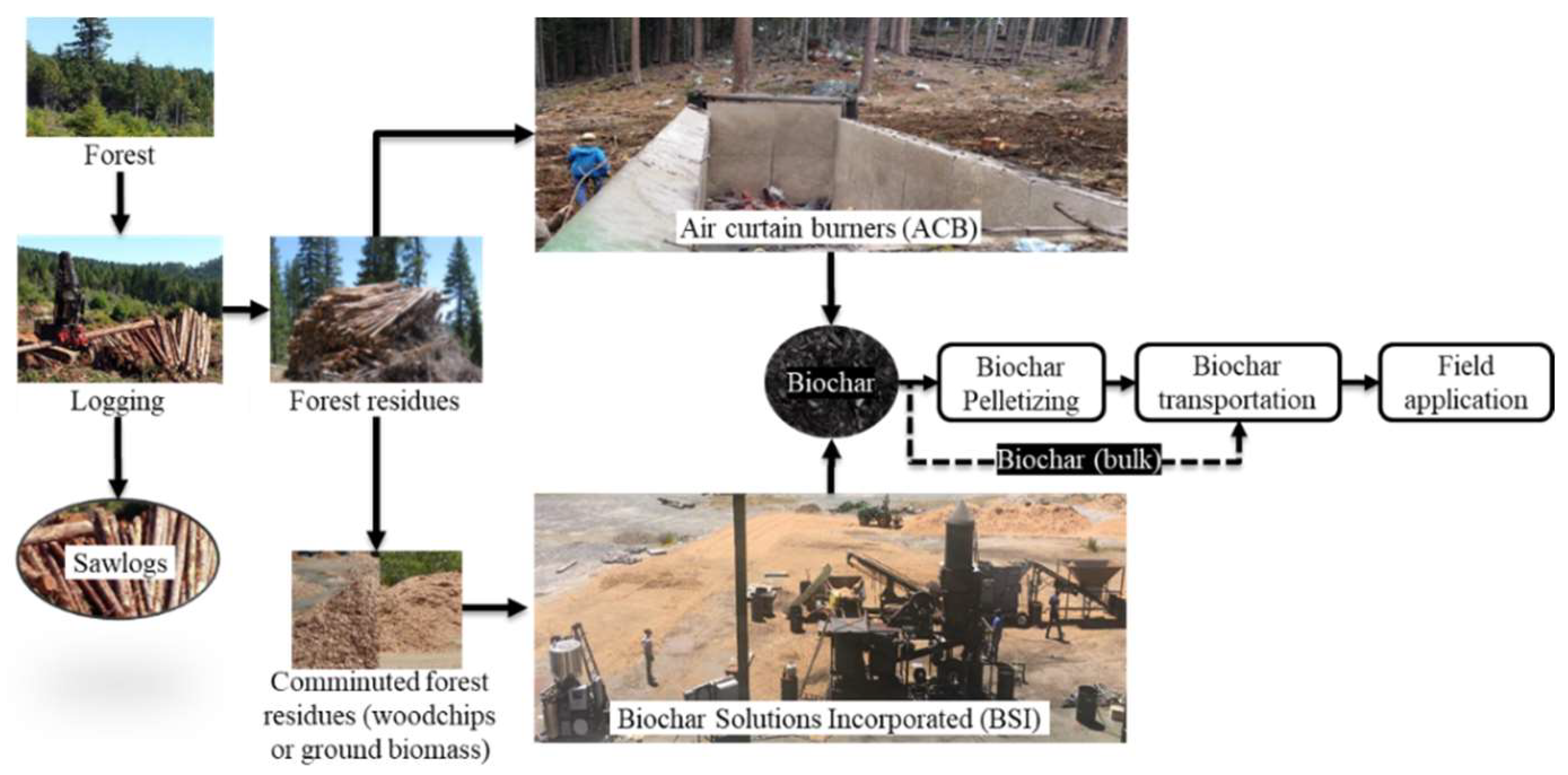
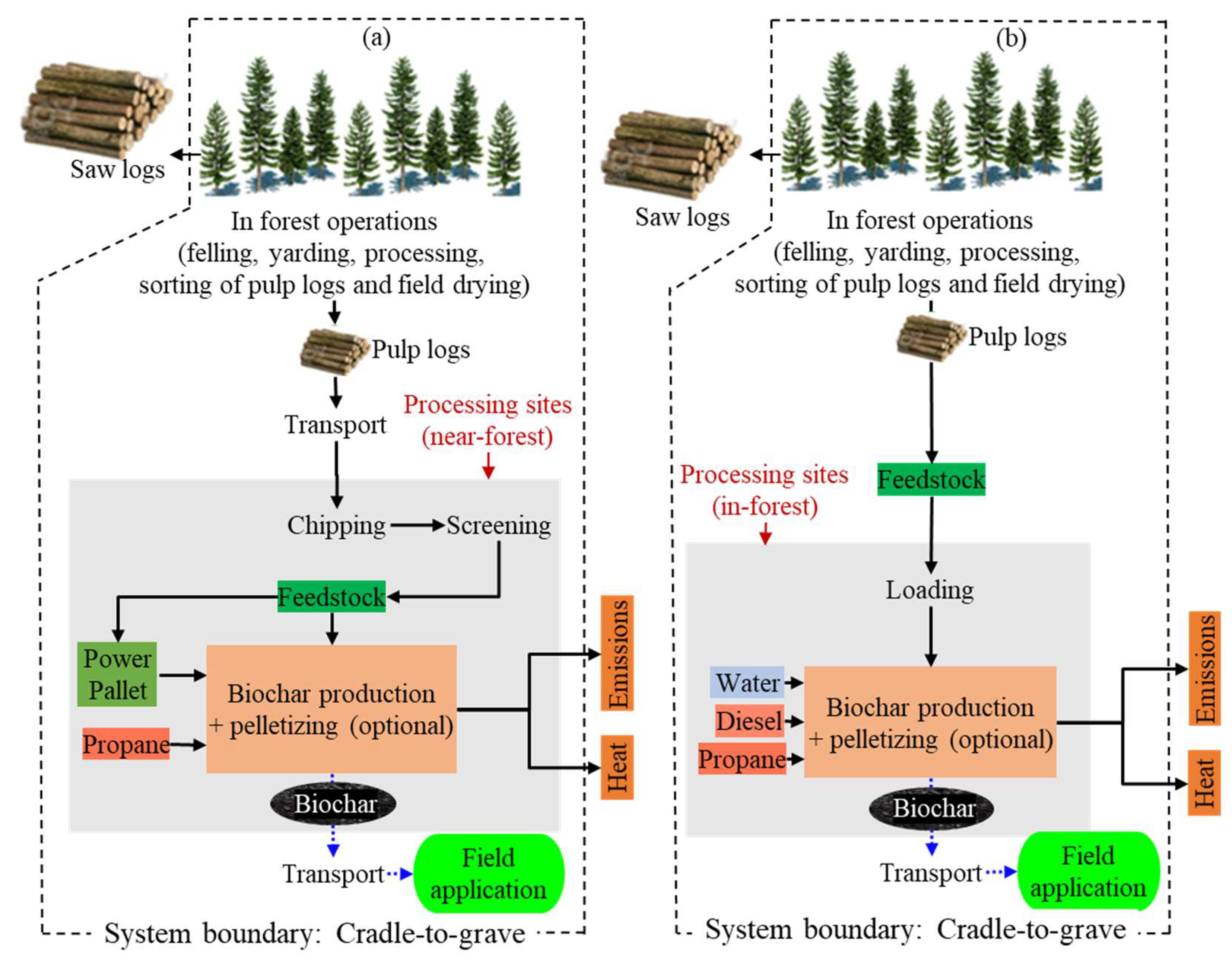
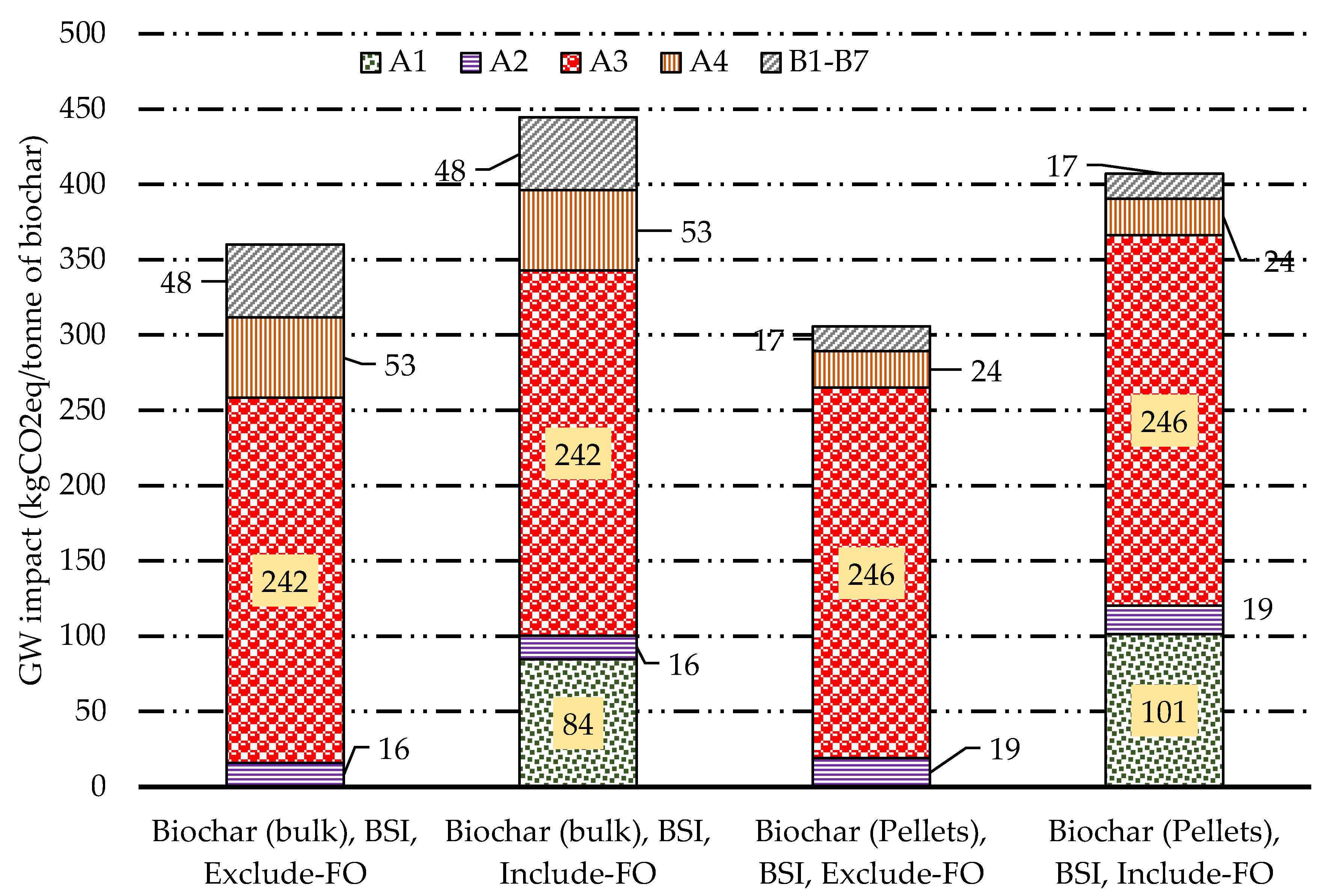
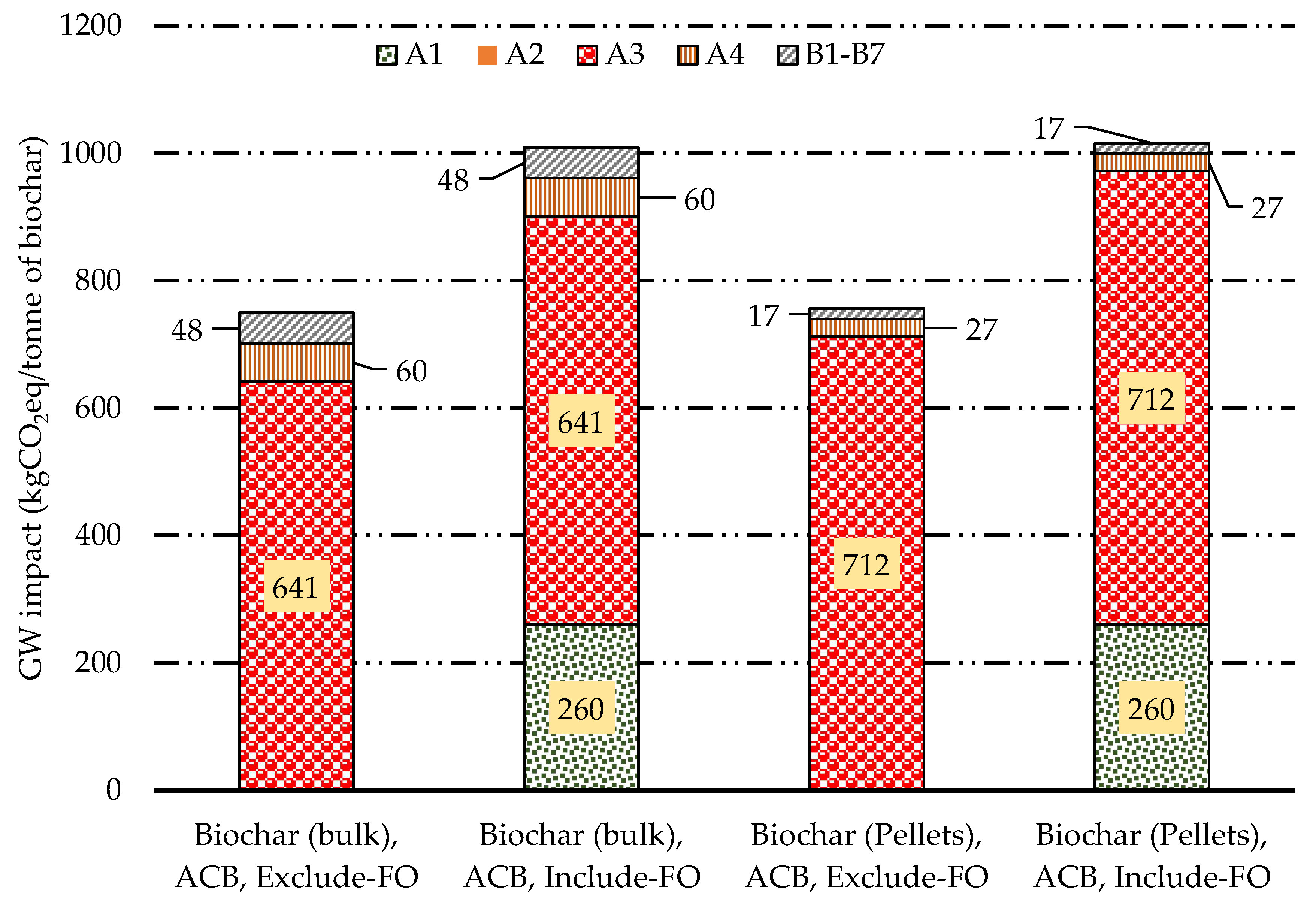
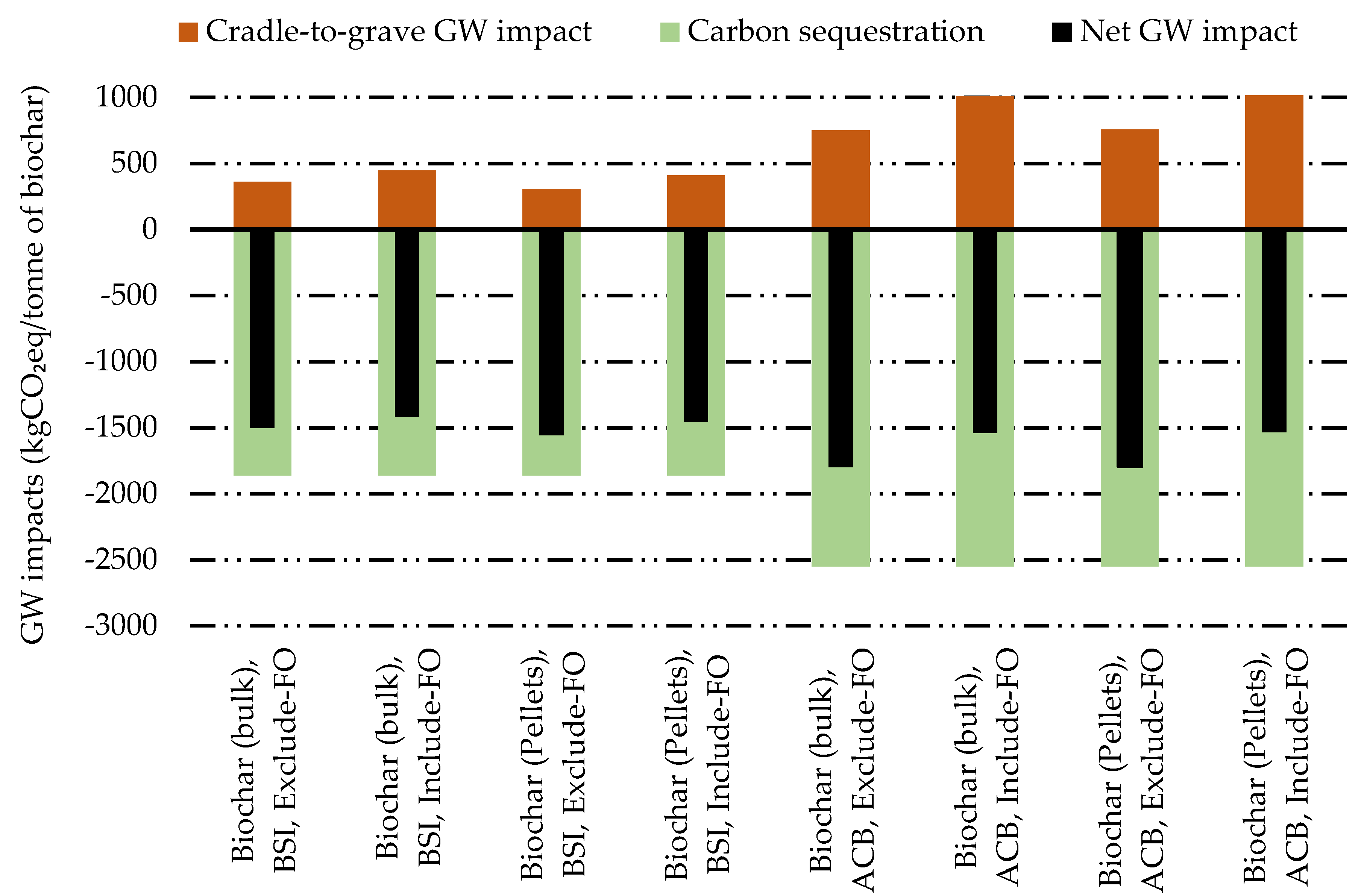
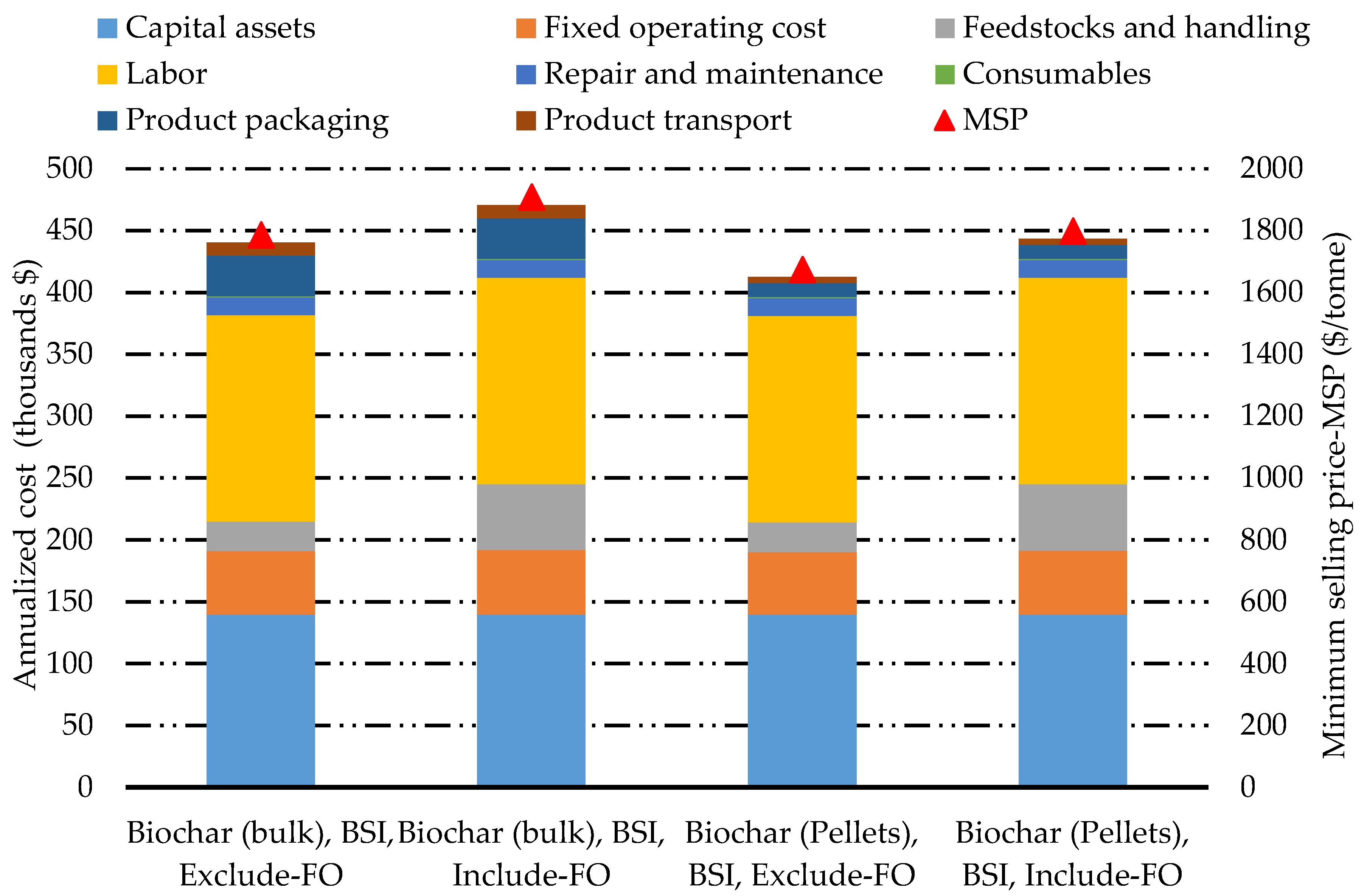
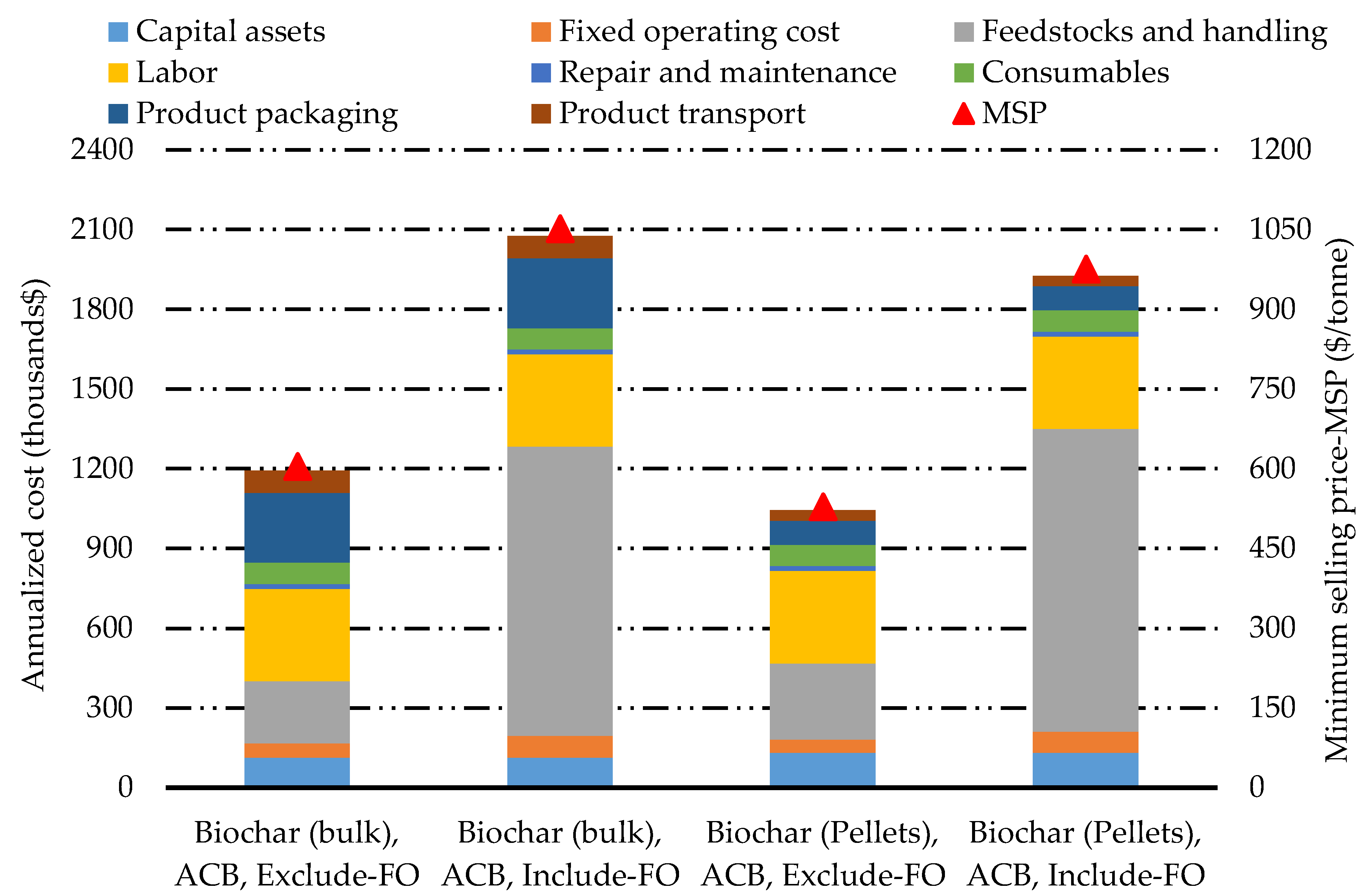
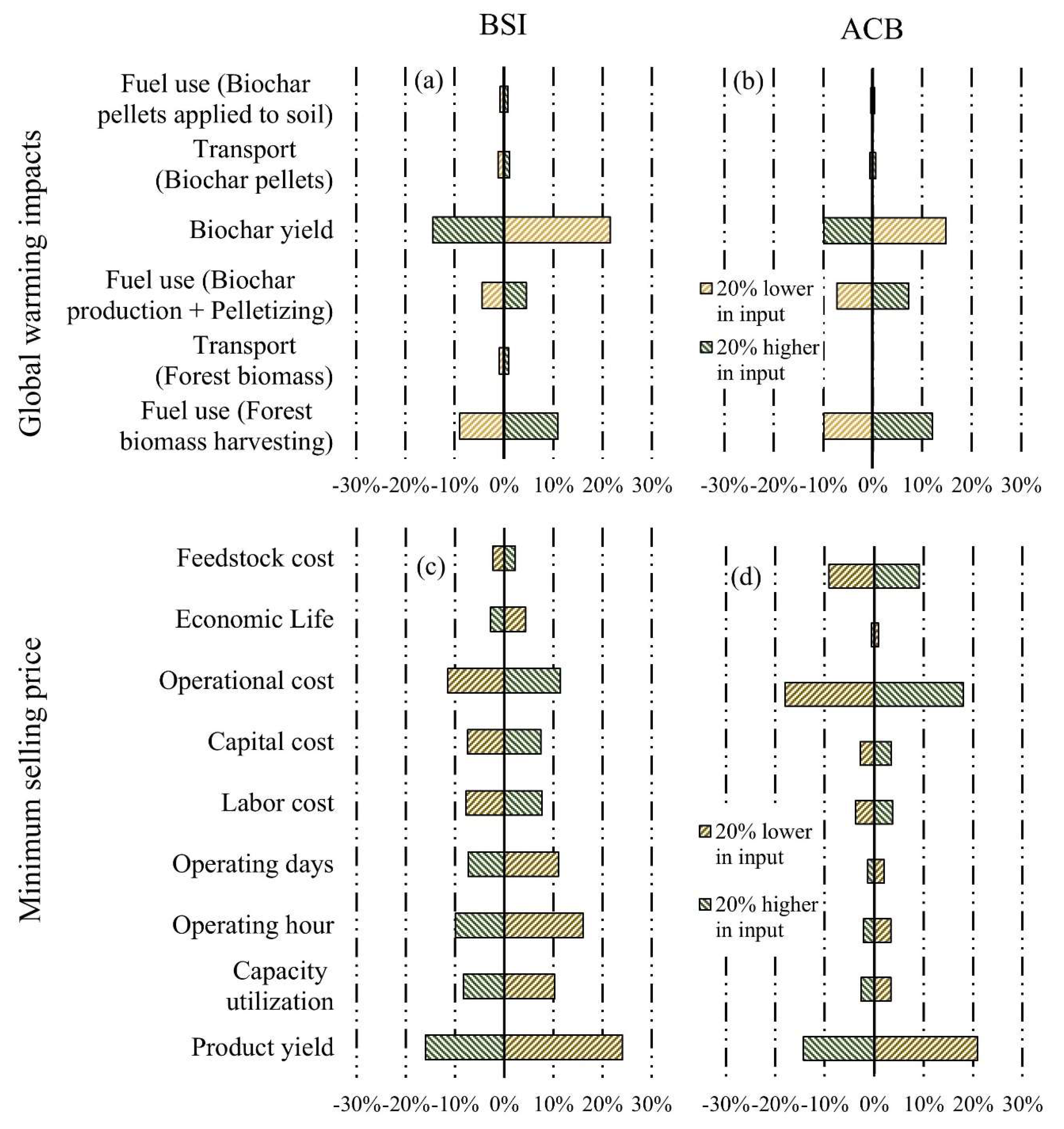
| Unit | Including Forest Operations † | Excluding Forest Operations | |
|---|---|---|---|
| Harvesting | |||
| Diesel | L | 6.4 | 2.1 |
| Gasoline | L | 0.12 | 0.04 |
| Forest residue transport (harvesting to landing) | km | 19.2 | 19.2 |
| Preprocessing ‡ | |||
| Diesel | L | 3.4 | 3.4 |
| Gasoline | L | 0.062 | 0.062 |
| Unit | BSI | ACB | |
|---|---|---|---|
| Input resources | |||
| Feedstock | kg (OD) | 5932 | 15,385 |
| Efficiency (biochar yield per ODT of forest residues) | % | 16.4% | 6.5% |
| Gasifier-based generator’s woody biomass input | kg | 707 (+127 †) | N/A |
| Diesel | L | 18 | 105 (+23 ‡) |
| Propane | L | 8 | 1 |
| Water (for quenching) | L | 0 | 2000 |
| Output products | |||
| Biochar (as bulk or pellets forms) | ODT | 1 | 1 |
| Fixed carbon | % | 65 | 89 |
| Unit | Biochar (Bulk) | Biochar (Pellets) | |
|---|---|---|---|
| Transportation | |||
| Transport distance | km | 50 | 50 |
| Biochar application | |||
| Diesel | L | 9.8 | 3.4 |
| Gasoline | L | 6.4 | 2.2 |
| Equipment | No of Units | Purchase Price (USD) | Economic Lifetime (Year) | Salvage Value (%) |
|---|---|---|---|---|
| Tractor | 1 | 15,000 | 10 | 20% |
| Biochar production machine | 2 | 340,000 | 10 | 20% |
| Pelletizer [39] | 1 | 19,899 | 10 | 20% |
| Gasifier genset | 2 | 25,000 | 10 | 10% |
| BSI: Biochar (bulk) production system 1 | 745,000 | |||
| BSI: Biochar pellet production system 2 | 764,899 | |||
| Equipment | No of Units | Purchase Price (USD) | Economic Lifetime (Year) | Salvage Value (%) |
|---|---|---|---|---|
| Air curtain burner | 1 | 168,900 | 10 | 20% |
| CAT Loader | 1 | 432,268 | 10 | 20% |
| Pelletizer [39] | 1 | 62,864 | 10 | 20% |
| Generator | 1 | 39,250 | 10 | 10% |
| ACB: Biochar (bulk) production system 1 | 601,168 | |||
| ACB: Biochar pellet production system 2 | 703,283 | |||
| Descriptions | Units | BSI | ACB | Source |
|---|---|---|---|---|
| Relocations | USD/year | 22,636 | 1368 | Estimated |
| Repair and maintenance | USD/year | 11,399 (+307 †) | 6132 (+1042 †) | Estimated |
| Consumables ‡ | USD/year | 8016 | 332,574 (+52,504 *) | Estimated |
| Labor | USD/year | 166,800 | 83,400 | Estimated |
| Insurance and miscellaneous | USD/year | 14,433 (+170 †) | 13,222 (+860 †) | Estimated |
| Total operating cost | USD/year | 223,284 (+477) | 436,696 (+53,364) |
Publisher’s Note: MDPI stays neutral with regard to jurisdictional claims in published maps and institutional affiliations. |
© 2022 by the authors. Licensee MDPI, Basel, Switzerland. This article is an open access article distributed under the terms and conditions of the Creative Commons Attribution (CC BY) license (https://creativecommons.org/licenses/by/4.0/).
Share and Cite
Bergman, R.; Sahoo, K.; Englund, K.; Mousavi-Avval, S.H. Lifecycle Assessment and Techno-Economic Analysis of Biochar Pellet Production from Forest Residues and Field Application. Energies 2022, 15, 1559. https://doi.org/10.3390/en15041559
Bergman R, Sahoo K, Englund K, Mousavi-Avval SH. Lifecycle Assessment and Techno-Economic Analysis of Biochar Pellet Production from Forest Residues and Field Application. Energies. 2022; 15(4):1559. https://doi.org/10.3390/en15041559
Chicago/Turabian StyleBergman, Richard, Kamalakanta Sahoo, Karl Englund, and Seyed Hashem Mousavi-Avval. 2022. "Lifecycle Assessment and Techno-Economic Analysis of Biochar Pellet Production from Forest Residues and Field Application" Energies 15, no. 4: 1559. https://doi.org/10.3390/en15041559
APA StyleBergman, R., Sahoo, K., Englund, K., & Mousavi-Avval, S. H. (2022). Lifecycle Assessment and Techno-Economic Analysis of Biochar Pellet Production from Forest Residues and Field Application. Energies, 15(4), 1559. https://doi.org/10.3390/en15041559






